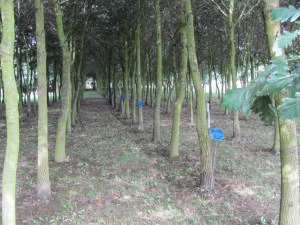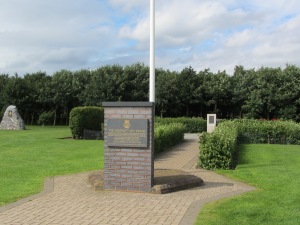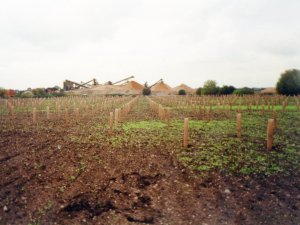Posts Tagged ‘merchant navy convoy’
A sailor’s life – 73. In Remembrance: Save our Ships

Trees and plaques – young oaks in the merchant navy convoy at the National Memorial Arboretum in Staffordshire, in August 2013
People called it the Phoney War – the autumn and winter of 1939, when gas masks were issued and children evacuated but nothing much else happened, apart from injuries in the blackout. Yet there was nothing “phoney” about those first months of the second world war for those at sea.
Less than nine hours after Neville Chamberlain’s radio broadcast to the nation at 11am on September 3rd (“No such undertaking has been received, and consequently this country is at war“), the unarmed passenger liner SS Athenia was attacked at dusk by U-30 and sunk – killing 99 passengers and 19 crew, including four stewardesses.
By May 1940, when Germany invaded Holland, Belgium and Luxembourg, an estimated 177 British merchant ships had been lost. “We shall fight on the beaches … on the landing grounds … in the fields and the streets …” in the air and on the seas and oceans, Winston Churchill told the Commons in June. “We shall never surrender.” But far out at sea, merchant ships risking their all to feed and fuel the “war effort” continued to be quietly lost in ever greater numbers – unreported by the newspapers, to protect morale. In vain, my grandmother searched for crumbs of news. By 1945 the toll of merchant vessels lost to enemy action was well over 2,500.
My grandfather, Bert Sivell, master of the Shell oil tanker Chama, and and all 54 officers and Chinese crew aboard his ship were among the estimated 35,000 merchant men and women who never came home again. Most of them have no grave. Many have not even a known spot far out at sea where they may be remembered.
Which is why the merchant navy “convoy” at the National Memorial Arboretum is so important to their families: 2,535 little oak trees, one for each ship lost, planted in straight lines stretching to the sunlit grasslands beyond. It is a moving, breathing memorial to the men who braved the Atlantic and the Arctic in mismatched convoys to keep the lifelines open – a rare sort-of resting place to visit.
Fifteen years ago, I bought an £80 plaque and travelled into Staffordshire to attend the dedication of this infant forest on behalf of my widowed grandmother, who hoped against hope, my father, who never had a father, and Bert’s great grandchildren – because oak trees take a hundred years.
Nowadays the National Memorial at Alrewas is a slick park, with broad paths, architect-designed monuments and a cafe, coach park and gift shop. There are hundreds of memorials, from the Shot at Dawn to the army dental corps, and thousands of wreaths and visitors.
But in 1998 it was a muddy field, with a few gallant old men hobbling along duck boards to a damp marquee, and all there was to see of their convoy was a knee-high patch of rabbit-proof tubes containing 2,535 twigs none of us would live to see full grown. Old, old men jangling with medals from the Atlantic and Russian convoys.

… and now, the merchant navy convoy all grown up – and facing the chop – at the National Memorial Arboretum, Staffordshire
We were told then that the trees would be spaced out. It seems we misunderstood.
This autumn felling will start, because the little trees, now high over my head, are too close together. Many are already suffering from lack of light. My grandfather’s tree is dead, the plaque for Chama marking a forlorn stump in its row. It seems the symbolic 2,535 oaks will from now on be “thinned” until eventually only about 700 remain. Even the infinity sightlines cannot be maintained.
“Can’t you replant?” I wailed down the phone to the assistant curator of grounds. No. That many mature oaks would require a space “half the size of Yorkshire”, he said. Or at least the whole 150 acres of the arboretum.
So the convoy as it grows must shrink, tree by tree, ship by ship, as indeed convoys were wont to do at dawn and dusk. For the moment the stumps still stand, maintaining their formation, but soon the lines will break.
It was after the dispersal of ships from convoy OG56 that my grandfather, ploughing alone into the Allies’ undefendable “Gap” in mid-Atlantic, bound for Curacao with only an ancient WWI Japanese gun for protection, was overtaken and picked off by U-97.
It was a grand idea, our merchant navy convoy. Maybe not practical. But very precious to the memory of those who have no grave but the sea. I am glad I saw it as it was intended.
I am also glad the old shipmates with the jangling medals will not see what is to come.
Lest we forget.
Read on – Monkbarns: Britain’s last Cape Horner?
Previously – Death of a master
Written by Jay Sivell
September 2, 2013 at 7:19 pm
Posted in 4. The war at sea, 1939-, Chinese seamen, Other stories, Shell oil tankers, WWII
Tagged with Anglo-Saxon Petroleum Company, Athenia, Bert Sivell, British shipping losses WWII, Chama, death at sea, handelsmarine, Isle of Wight & Sivell family, koopvaardij, life at sea, marina mercante, marine marchande, merchant navy, merchant navy convoy, merchant navy losses, National Memorial Arboretum, Neville Chamberlain, oil tankers - Shell, seamen's monuments, Shell oil tankers, Shell tankers, war at sea, We shall fight them on the beaches, Winston Churchill



